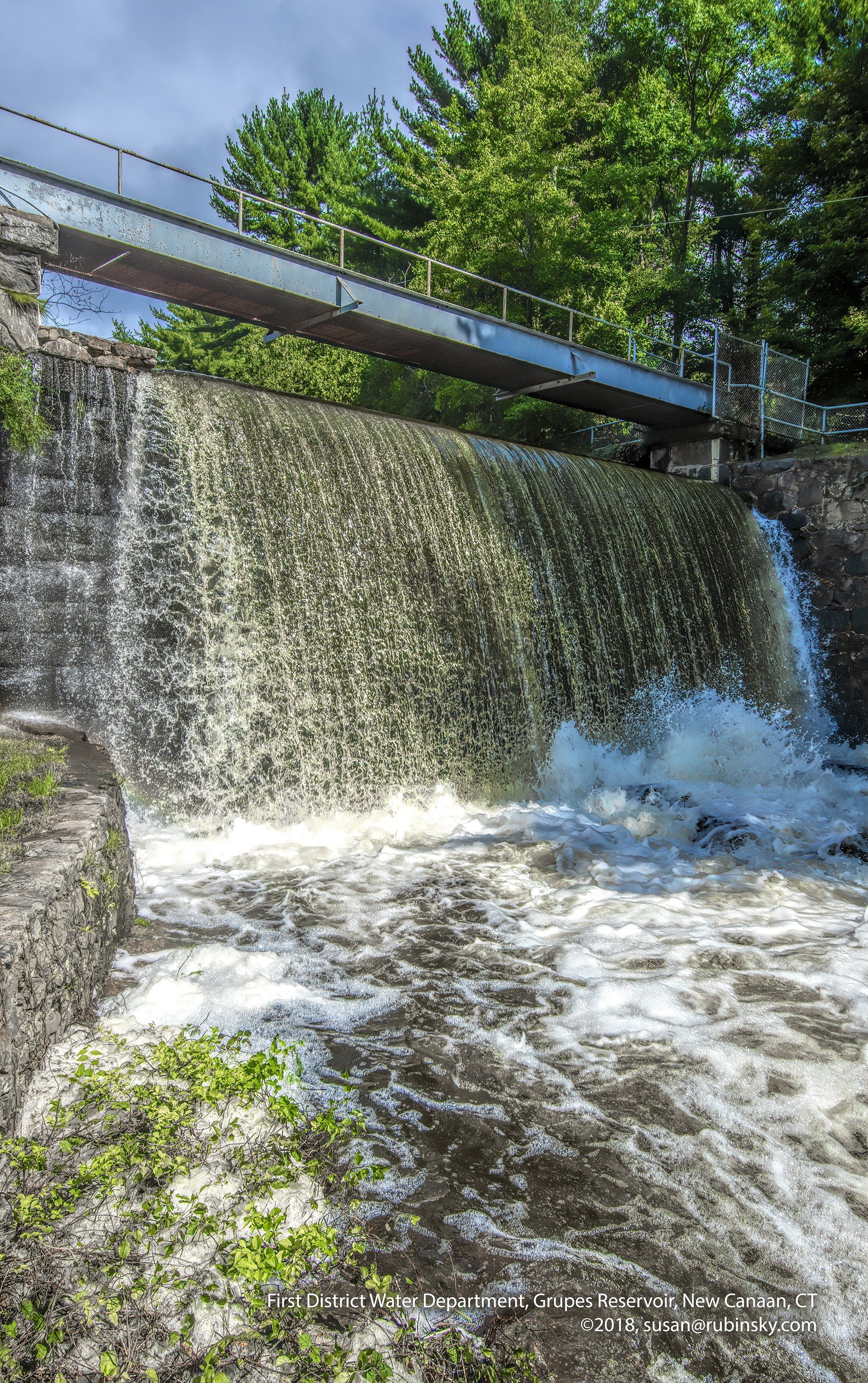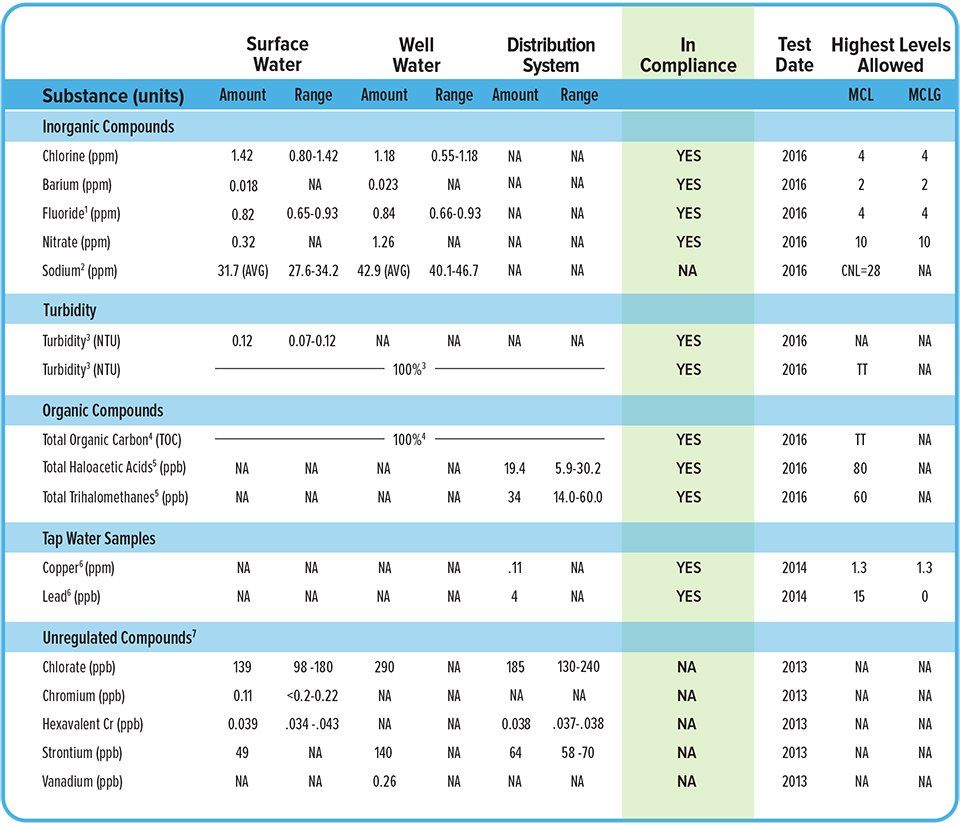2016 Water Quality Report
Letter to Our Customers
Dear Customer:
It is with great pride that we present you with this year’s Water Quality Report. The First District Water Department has again achieved the goal of meeting the very stringent water quality standards set by federal and state regulatory agencies. This report covers water testing performed throughout 2016.
Our number one priority is to provide a safe and reliable supply of drinking water to our customers. Each year the water department laboratory processes hundreds of water quality analyses for compliance purposes. This testing includes the source water, the treated water as it leaves the filtration plant and wellfield, and the water as it travels through the distribution system pipes and into your homes and businesses.
Water quality has continued to be a topic of concern throughout many cities, with important issues like lead and other contaminants in the news this year. Please take this opportunity to read the report and educate yourself on water quality.
We invite your inquiries in writing or participation at a monthly Board of Commissioners meeting in our main office, 12 New Canaan Avenue, Norwalk 06851. You may phone (203) 847-7387 for the times and dates of meetings. You should also feel free to contact us or the Department’s General Manager, Dominick M. Di Gangi, P.E., or visit our website www.firstdistrctwater.org for additional information.
Sincerely,
Frank N. Zullo, Esq. ChairmanCommissioners, First Taxing District
2016 Water Sampling
During the past year the FDWD staff has taken hundreds of water samples in order to determine the presence of any biological, inorganic, volatile organic or synthetic organic contaminants. These samples were taken at the reservoirs, the treatment plant, and the well field and also at representative sample sites around the distribution system. The table below shows only those regulated substances that were detected in the treated water. All of the substances found meet all state and federal standards. Regulation requires that some substances are monitored less than once per year. The year sampled is noted in the table.
Footnotes
1 - Amount detected; ranges are monthly averages.
2 - There is no federal MCL for sodium but Connecticut has established a notification level of 28 mg/L. If you have been placed on a sodium-restricted diet please inform your physician of the sodium content in our water. For people on a regular diet this level of sodium is very low.
3 - Turbidity is a measure of the clarity of the water. It is montored because it is a good indicator of the effectiveness of the filtration system. 95% of the samples need to be less than 0.3. 100% of the The District’s samples were less than 0.3.
4 - The District’s water met the required removal rate 100% of the time.
5 - Amount is that of the highest annual average of quarterly measurements in the distribution system and the range are results of the individual sites.
6 - Tap water samples were collected for lead and copper analyses from 34 homes throughout the service area. The lead and copper results at the 90th percentile did not exceed the AL (listed in table under Distributions System). A lead sample from one home had a result that exceeded the AL.
7 - Unregulated Contaminant Monitoring Regulation (UCMR) 2 monitoring was completed in 2013. There is a list of 10 selected contaminants which do not yet have a drinking water standard set by the EPA. The purpose of the monitoring is to help the EPA decide whether the contaminants should have a standard. We detected five of these contaminants in either our surface or groundwater supplies.
Acronyms and Definitions
AL (Action Level)
- The concentration of a contaminant which, if exceeded, triggers treatment or other requirements which a water system must follow.
CNL
- State of CT Customer Notification level
MCL (Maximum Contaminant Level)
- The highest level of a contaminant that is allowed in drinking water. MCLs are set as close to the MCLGs as feasible using the best available treatment technology.
MCLG (Maximum Contaminant Level Goal)
- The level of a contaminant in drinking water below which there is no known or expected risk to health. MCLGs allow for a margin of safety.
MRDL (Maximum Residual Disinfectant Level)
- The highest level of a disinfectant allowed in drinking water. There is convincing evidence that addition of a disinfectant is necessary for control of microbial contaminants.
MRDLG (Maximum Residual Disinfectant Level Goal)
- The level of a drinking water disinfectant below which there is no known or expected risk to health. MRDLGs do not reflect the benefits of the use of disinfectants to control microbial contaminants.
NA
- Not Applicable
NTU (Nephelometric Turbidity Units)
- Measurement of the clarity, or turbidity, of water. Turbidity in excess of 5 NTU is just noticeable to the average person.
ppb (parts per billion)
- One part substance per billion parts water (or micrograms per liter).ppm (parts per million) - One part substance per million parts water (or milligrams per liter).
TT (Treatment Technique)
- A required process intended to reduce the level of a contaminant in drinking water.
Compound Sources
Barium
- Natural deposits due to erosion
Chlorine
- Water additive used to control microbes
Copper
- Deposits from household plumbing systems
Fluoride
- Additive for strong teeth; natural deposits due to erosion
Lead
- Deposits from household plumbing systems
Nitrate - Fertilizer runoff; leaching from septic tanks and sewage; natural deposits due to erosion
Sodium
- Water treatment systems; road salt runoff; natural deposits in environment
Turbidity
- Sediment particles; naturally occurring iron and maganese; soil runoff
Request
More Information
For more information or questions about this report, please contact our Laboratory Coordinator, Dana Dessereaux at ddessereaux@firstdistrictwater.org or 203-229-7273.
About Our Water
How FTDWD Water Is Treated
The reservoir water is filtered at our treatment plant in New Canaan. The filtered water is then disinfected with chlorine to protect against any bacteria. We carefully monitor the amount of chlorine, adding the lowest quantity necessary to ensure the safety of your water without compromising the taste. Finally, chemicals are added to adjust the acidity, reduce the corrosivity and coat the pipes. This protects the pipes and keeps leaching of minerals such as lead and iron to a minimum. Fluoride is also added to prevent tooth decay. At the well field, the groundwater is filtered naturally by sand and gravel. The water is then treated in a similar manner as the surface water with the addition of aeration which removes contaminants and raises the pH.

Water Quality & Sustainability
Health Information
From the EPA
This statement is prescribed by the US Environmental Protection Agency for your information.
Sources of lead in drinking water include corrosion of household plumbing system and erosion of natural deposits.
Fluoride
New Fluoride Level Established in CT
On October 1, 2016 the Connecticut General Statutes were revised to lower the amount of fluoride added to water for Community water systems. The recommended level from the US Department of Health and Human Services to prevent tooth decay is currently 0.7 mg/L; therefore the FDWD is now required to maintain the fluoride content between 0.55 and 0.85 mg/L as a monthly average.
Substances in Water
Substances That Might Be in Drinking Water
To ensure that tap water is safe to drink, the U.S. EPA prescribes regulations limiting the amount of certain contaminants in water provided by public water systems.
Lead
Lead and Drinking Water
If present, elevated levels of lead can cause serious health problems, especially for pregnant women and young children.



